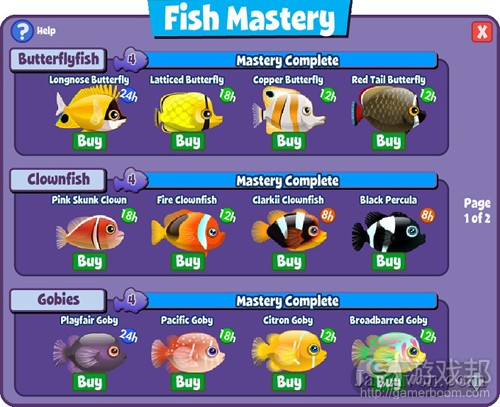Roger Dickey分享增强社交游戏盈利性的经验
来源:互联网 发布:php初级程序员要求 编辑:程序博客网 时间:2024/04/30 07:40
Roger Dickey分享增强社交游戏盈利性的经验
作者:Tyler York
Roger Dickey是Zynga游戏《Mafia Wars》开发者,之前是《FishVille》游戏项目总经理,现在则是Zynga日本和中国部门的国际产品顾问。他最近在我们的Game Monetization讲座上分享了与社交游戏盈利性相关的内容。(请点击此处查看视频内容)

FishVille(from gamezebo.com)
粘性是游戏的核心所在
Roger Dickey首先强调了开发社交游戏需重视的三个R,即用户接触面(Reach)、用户留存情况(Retention)和盈利性(Revenue)。
*用户接触面是指游戏通过玩法、Facebooke及Twitter病毒传播渠道可触及的用户数量;
*留存情况是长期在游戏中逗留的用户数量;
*盈利性当然就是指赚钱。
Roger称假将社交游戏绘制成一张图表,居于正中的就是游戏粘性。他将粘性视为游戏的核心,因为“它可以有效地向游戏的其他各个环节输血”。粘性较高的用户可通过与好友分享游戏内容,提高游戏的用户接触面,他们回访游戏的频率和付费意愿都比较高。
“痛苦的乐趣”
这是Roger的一个有趣观点,他将此称为社交游戏成功的关键。举例来说,《FarmVille》玩家需要逐个点击每块田地种植或收割庄稼,他们乐在其中同时又觉得有点琐碎烦人,这种现象就是“痛苦的乐趣”。而这种元素却给Zynga的那些“止痛”道具(游戏邦注:例如可一次性点击选中四块地的拖拉机等)创造了商机,这些道具成了玩家的抢手货,虽然它们存在的理由就是游戏任务有点烦人!
刷任务 vs. 求助信息 vs. 付费
社交游戏的特殊道具设置大同小异,经常会出现许多需要由多个零件组合的道具。一般来说,玩家都可以通过三种途径获得特殊道具:
1.长期刷任务以积攒足够的分值或点数;
2.向好友发送信息请求,让他们提供你所需要的零件;
3.付费购买你所需要的零件。
多数玩家刚开始时都会采用刷任务或向好友求助的方式以实现目标,但他们厌倦枯燥的刷任务机制,或者没有收到好友的回应之后,就只能得到一个尚未完工并且无甚用处的半成品。这时他可能就会付费买道具完成任务。

fish Mastery(from jayavon.com)
估算游戏盈利性
Roger认为有一个方法可粗略估算一款休闲类社交游戏的盈利性:
*一个能量机制的ARPU为0.03美元
*一个装饰性元素的ARPU为0.02美元
*竞争性玩法的ARPU为0.05美元
玩家付费原因
Roger发现人们为社交游戏掏钱的原因包括:
表达个性
玩家愿意为游戏中涉及社交层面的内容付费,以便向好友展示自己的农场、城市或虚拟形象。
虚荣
这个因素拉动了独门道具的用户需求:玩家喜欢购买那些限量供应的道具,或者先于他人得到某些稀有的东西。
乐趣
对许多玩家来说,那些可为游戏带来便利性,以及减轻“痛苦乐趣”中“痛苦”元素的东西很值得他们掏钱。
独特功能
在免费增值游戏领域,玩家只有付费才能访问某些特定功能或玩法,这也是增强游戏盈利性的一个重要途径。
竞争
硬核玩家,尤其是男性用户通常会购买有助于打败竞争对手的东西。
社交价值
玩家希望好友也参与游戏,并向他们提供帮助,他们增加了好友对游戏的粘性。当影响力也具有社交性之后,它就会增值并促使人们为其解囊。

fishville(from flipthemedia.com)
机会
Roger发现随机性也可以成为人们消费的一大动机。
进程
玩家会为加速游戏进程,或者在游戏中暂时得利而掏钱,竞争型游戏更是如此。
故事
令人意外的是,玩家也会为推动故事进展而付费。他们完成任务时就会感到自己进步了,并掏钱扫清阻碍故事发展的因素。
反馈参数
Roger奉行在游戏问世之时就将数据反馈系统考虑入内的原则。他建议开发商记录下玩家在游戏中的每一次点击或行动,虽然这会产生庞大数据,但这种做法确实值得采纳。他经常从那些自己创建反馈系统时从未想过要收集的数据中了解到更多的玩家行为。
区分玩家类型
将玩家划分为不同类型对游戏运营十分重要。Roger建议开发商不要局限于硬核vs休闲玩家的二分法,他推荐使用以下标准将玩家归类:
*游戏频率——他们多长时间玩一次游戏
*社交度——玩家与好友分享内容的意愿有多高
*消费历史记录——他们为游戏道具付费的频率
*玩家寿命—–他们之前玩游戏的时间有多长,他们将在游戏中投入多少时间
营造游戏主题氛围
Roger Dickey之前在任《FishVille》项目总经理时,他们团队曾投入大量时间营造一种与游戏主题有关的办公室氛围。他们饱览有关鱼类的书籍,在四壁张贴鱼类海报,让团队所有人都沉浸于这种水底世界。当召开设计会议时,大家心里自然就有了大量关于游戏玩法和内容的新想法。
盈利计划
最后,Roger强调了掌握游戏盈利计划的重要性。这意味着游戏设计之时就要考虑到项目盈利方式。他对此提出了一些参考建议和策略:
负强化
玩家自己创造的产物就是其对游戏的粘性所在。玩家不想让鱼类死亡并飘浮到水面,让好友看到如此不堪的鱼缸和水箱。
公平性
需注意的是,玩家其实并不像设计师所想象的那样在乎付费用户与非付费用户之间的公平性。
易消耗品
Roger在日本推出一款竞争型游戏时,他深入研究了《Kaido Royale》这款风格类似于《Mafia Wars》的游戏特点。该游戏玩家不但需要购买枪支,而且还要为子弹掏钱,这种易消耗系统对游戏盈利性产生了巨大贡献。
能量
“如果你给人们一大桶糖果,他们可能只会享受一周,然后就再也不光顾了。但如果每天只给他们10颗糖,他们就会长年回访。”
付费装饰品
“《FarmVille》在某种程度上其实是一个让人们装饰点缀的画布”。
扩展地盘
在那些将建设作为长期目标的游戏中,扩展地盘是游戏最不容忽视的环节。
季节性内容
它有助于增加游戏的吸引力及动态,以此维持用户留存率。
广告赞助
这也是增加收益的一个好方法,只是要注意不可让赞助内容喧宾夺主,把玩家引向他处。
免费虚拟货币
这种商品的盈利性不高,但低级别的玩家可能会需要这些虚拟货币加快游戏进程或完成任务。
首次消费动机
为了让玩家从免费向付费用户过渡,开发商应制造一些首次消费动机,让那些从未完成一笔交易的玩家迈出这关键的第一步。
赌注
可以让玩家为游戏结果下注,Betable是首个支持游戏开发者将其植入游戏系统的此类服务平台。(本文为游戏邦/gamerboom.com编译,拒绝任何不保留版权的转载,如需转载请联系:游戏邦)
Roger Dickey’s Tactics for Game Monetization
by Tyler York
Hey all, check out the video below. I would love to embed it but the HTML embed doesn’t seem to be working at this time (or I am failing to get it to work). Still, it’s a great video and worth a watch. I have also provided cliff notes below for those that want them.
Roger Dickey is the creator of Mafia Wars, one of the most successful social games of all time, and was the GM of FishVille at Zynga before becoming an international product advisor in their Japan and China divisions. He recently spoke at our Game Monetization meetup event, “Money Talks”. There’s a ton of great wisdom in this video and I wanted to share it with the Gamasutra community.
http://vimeo.com/32161327
Engagement is the heart of your game
Roger Dickey started off his presentation outlining the three R’s of social games:
Reach, Retention, and Revenue.
Reach is how many people that your game touches, both through gameplay and also impressions in viral channels such as Facebook and Twitter.
Retention is how many people keep playing your game over time.
Revenue is money, of course.
Roger argues that if these were in a graph, engagement would be in the center. He compares engagement to the heart of your game because “it is effectively pumping blood to every other part of your game”. Engaged users will help you reach more people by sharing the game with your friend, they will retain longer, and they will be more willing to pay.
“Fun Pain”
One of Roger’s most interesting points was that “fun pain” was the key to social games’ success. Think about how a player needed to click each square to plant or harvest their crops in Farmville. This is a perfect example of “fun pain”, something that is simultaneously entertaining and a little bit annoying. This also gave Zynga the opportunity to upsell the player on pain-reducing items, such as a tractor that clicked four fields at once. These items were extremely popular among players, even though they only existed because it was painful to play the game in the first place!
Grind vs. Spam vs. Pay
Social games work in much the same way when it comes to special items. This is frequently employed with special items that are built via a combination of parts. Typically, you can earn the parts for the special item in three ways:
Grind for them over a long period of time
Spam your friends to have the send you the pieces you need
Pay for the parts that you are missing
Players almost always start with Grind or Spam to kick off their pursuit of the item. However, as the player grows weary of grinding and doesn’t see the response he was hoping for from his friends, he is left with a partially completed item and no use for the parts. Now, the user is willing to pay for the item to be completed.
Estimating your game’s monetization
A simple, rough formula to estimate how much a casual social game could be broken out as follows:
An energy mechanic was worth $0.03 ARPU
A decorative factor was worth $0.02 ARPU
Competitive gamplay was worth $0.05 ARPU
This is a pretty high level estimation that begs the question…
What do people pay for?
Roger found that people pay for the following in social games:
Identity expression
Players will pay for anything that is socially surfaced in the game because you’re presenting your farm, city, or avatar to your friends.
Vanity
This drives demand for exclusive items: people will pay more when there is only a limited number of an item available, or to get things before other players.
Fun
Items that make the game more convenient and tip the “fun pain” scale more towards fun are worth a lot to a wide variety of players.
Exclusive features
Having certain features or aspects of gameplay only become available for a fee can be an effective monetization model, as we see often with freemium software.
Competition
Hardcore players, especially males, will pay to get a competitive advantage against their opponents.
Social value
Your players want their friends to play and by helping them, they increase their friend’s chance of sticking with the game. Once power becomes social, it becomes much more valuable and people pay for it.
Chance
Roger found that random chance was a huge incentive for people to buy. We wrote a blog post that highlights the power of the Mystery Box that covers this in more detail.
Stat Progress
Players will pay for progress or temporary power in a game, especially a competitive one.
Story
Surprisingly, people pay very well to advance the story. They feel a sense of progress when completing quests and will pay to overcome roadblocks in that progression.
Measure everything
Roger was adamant about launching with metrics already in place. Furthermore, he pushed for game studios to record every single click or action that players did in the game. This requires reams of data but is well worth it. Much of the insights that Roger gained about player behavior was from data that he didn’t even know he needed when he build his metrics systems.
Cohorts
Breaking your users into cohorts is an incredibly important tactic for monetizing your game. Roger’s recommended cohorts goes far beyond the typical hardcore vs. casual groupings. He recommended using the following cohorts:
Play Frequency – how often do people play
Socialness – how viral or willing to share are they
Spending profile – how often do they pay for an in-game item
Lifetime – how long have they been playing, how long will they play
Mine the theme space
When working at Zynga as GM for Fishville, Roger Dickey and his team spent a good amount of time doing what he calls “mining the theme space”. They read books on fish and put up fish posters around the office to make sure that they were immersed in the world they were creating. That way, when it came time for game design meetings, the team was usually full of new ideas for gameplay and content.
Master plan for monetization
Lastly, Roger emphasized the need for a master plan for game monetization. This means including monetization from the very onset of the design’s inception. To this end, he offered up a number of tips and strategies from his game monetization toolkit:
Negative reinforcement
Your obligation to your creations is a real driver of engagement. You don’t want your fish to die and float to the top of your tank, looking ugly and showing your neglect for all your friends to see.
Fairness
It is worth noting that players care much less about payer vs. non-payer fairness than a game designer would think.
Consumables
When working to launch a competing game in Japan, Roger studied Kaido Royale extensively. In this Mafia Wars-style game, you needed to not only buy a gun to use but also the bullets to fire the gun, and this consumable use system helped the game monetize extremely well.
Energy
“If you give somebody a huge bucket of candy, they’re gonna love the candy for a week, and then never want any again. If you give them 10 pieces a day, they’ll keep coming back for years”.
Premium decorations
“Farmville was at one point mostly a canvas for people to decorate on.”
Territory expansion
In any game where the long term goal is to build, territory expansion is a big part of the game.
Seasonal content
A necessary evil that helps the game retain users by keeping it interesting and dynamic.
Content grab bags
When buying multiple items at once, players simultaneously feel like they’re getting a deal and that they’re buying something more substantial than a virtual gun.
Sponsorship
This is a decent way to increase revenues, just don’t let sponsored content “go all Myspace and take over the whole game.”
Free currency
This doesn’t monetize well, but low level players will purchase free currency to advance faster or complete quests.
Collection completion
This means mechanics like ‘do this 10 times and master it’ in Mafia Wars. “It’s kind of funny sitting there as a game designer and being like ‘our game is already kind of mundane… what if we make everyone do things 10 times?’ Well, it can work.”
First time buyer incentive
To get people to convert from free-to-paid, first time buyer incentive gives players that haven’t purchased a ‘deal’ that gets them over that crucial first purchase hurdle.
Wagering
The ability to wager on the outcome of your game could be a game changer. Betable is the first platform that makes it possible for game developers to implement this in their games.(source:gamasutra)
- Roger Dickey分享增强社交游戏盈利性的经验
- 游戏社交不足怎么办? 游戏发行中的社交化运营经验分享
- 探讨盈利性对游戏乐趣的消极影响
- 一位前辈的游戏开发经验分享
- 腾讯社交广告算法大赛经验分享
- 社交平台的分享
- 开发商:Facebook硬核游戏更具盈利性—Flash的专注符合开发商需求
- 分享SNS社交网站的视觉设计经验(疯狂的IT人)
- 游戏项目开发经验分享
- 游戏项目开发经验分享
- 扎克伯格的社交分享定律
- 一些JavaScript的社交分享
- 社交分享--ShareSDK的使用
- 分享Unity工具十天创建iPad游戏的经验
- 分享Unity工具十天创建iPad游戏的经验
- 分享2D Unity游戏的动画制作经验
- HTML5游戏的经验技术与数据分享-张哲
- 分享2D Unity游戏的动画制作经验
- 如何搭建Android的开发环境->在unbuntu 10.04 上如何搭建android的编译环境(五)
- JOS实验——Exercise 10
- 使用 /proc 文件系统来访问 Linux 内核的内容
- python time模块详解
- Visual c++ 初学一
- Roger Dickey分享增强社交游戏盈利性的经验
- Back reference in a write_anywhere FS
- 病毒式传播2.0时代的社交游戏开发5要素
- 朋友,你是图中的哪个
- ZJU 1122
- 数组面试题之矩阵
- APIdemo详解,不断更新
- matlab中帮助命令
- 游戏引擎Andengine总结(二):AndEngine引擎运行原理


